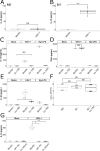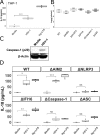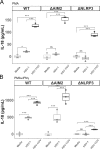Herpes simplex virus type 1 inflammasome activation in proinflammatory human macrophages is dependent on NLRP3, ASC, and caspase-1
- PMID: 32101570
- PMCID: PMC7043765
- DOI: 10.1371/journal.pone.0229570
Herpes simplex virus type 1 inflammasome activation in proinflammatory human macrophages is dependent on NLRP3, ASC, and caspase-1
Abstract
The proinflammatory cytokines interleukin (IL)-1β and IL-18 are products of activation of the inflammasome, an innate sensing system, and important in the pathogenesis of herpes simplex virus type 1 (HSV-1). The release of IL-18 and IL-1β from monocytes/macrophages is critical for protection from HSV-1 based on animal models of encephalitis and genital infection, yet if and how HSV-1 activates inflammasomes in human macrophages is unknown. To investigate this, we utilized both primary human monocyte derived macrophages and human monocytic cell lines (THP-1 cells) with various inflammasome components knocked-out. We found that HSV-1 activates inflammasome signaling in proinflammatory primary human macrophages, but not in resting macrophages. Additionally, HSV-1 inflammasome activation in THP-1 cells is dependent on nucleotide-binding domain and leucine-rich repeat-containing receptor 3 (NLRP3), apoptosis-associated speck-like molecule containing a caspase recruitment domain (ASC), and caspase-1, but not on absent in melanoma 2 (AIM2), or gamma interferon-inducible protein 16 (IFI16). In contrast, HSV-1 activates non-canonical inflammasome signaling in proinflammatory macrophages that results in IL-1β, but not IL-18, release that is independent of NLRP3, ASC, and caspase-1. Ultraviolet irradiation of HSV-1 enhanced inflammasome activation, demonstrating that viral replication suppresses inflammasome activation. These results confirm that HSV-1 is capable of activating the inflammasome in human macrophages through an NLRP3 dependent process and that the virus has evolved an NLRP3 specific mechanism to inhibit inflammasome activation in macrophages.
Conflict of interest statement
The authors have declared that no competing interests exist.
Figures





Similar articles
-
NLRP3, NLRP12, and IFI16 Inflammasomes Induction and Caspase-1 Activation Triggered by Virulent HSV-1 Strains Are Associated With Severe Corneal Inflammatory Herpetic Disease.Front Immunol. 2019 Jul 16;10:1631. doi: 10.3389/fimmu.2019.01631. eCollection 2019. Front Immunol. 2019. PMID: 31367214 Free PMC article.
-
Non-transcriptional regulation of NLRP3 inflammasome signaling by IL-4.Immunol Cell Biol. 2015 Jul;93(6):591-9. doi: 10.1038/icb.2014.125. Epub 2015 Jan 20. Immunol Cell Biol. 2015. PMID: 25601272 Free PMC article.
-
Myxoma virus lacking the pyrin-like protein M013 is sensed in human myeloid cells by both NLRP3 and multiple Toll-like receptors, which independently activate the inflammasome and NF-κB innate response pathways.J Virol. 2011 Dec;85(23):12505-17. doi: 10.1128/JVI.00410-11. Epub 2011 Sep 28. J Virol. 2011. PMID: 21957307 Free PMC article.
-
[Inflammatory bowel diseases and inflammasome].Korean J Gastroenterol. 2011 Dec;58(6):300-10. doi: 10.4166/kjg.2011.58.6.300. Korean J Gastroenterol. 2011. PMID: 22198227 Review. Korean.
-
Structural Mechanisms of NLRP3 Inflammasome Assembly and Activation.Annu Rev Immunol. 2023 Apr 26;41:301-316. doi: 10.1146/annurev-immunol-081022-021207. Epub 2023 Feb 7. Annu Rev Immunol. 2023. PMID: 36750315 Free PMC article. Review.
Cited by
-
Korean Chestnut Honey Suppresses HSV-1 Infection by Regulating the ROS-NLRP3 Inflammasome Pathway.Antioxidants (Basel). 2023 Oct 30;12(11):1935. doi: 10.3390/antiox12111935. Antioxidants (Basel). 2023. PMID: 38001788 Free PMC article.
-
The Crucial Role of NLRP3 Inflammasome in Viral Infection-Associated Fibrosing Interstitial Lung Diseases.Int J Mol Sci. 2021 Sep 28;22(19):10447. doi: 10.3390/ijms221910447. Int J Mol Sci. 2021. PMID: 34638790 Free PMC article. Review.
-
Infection of Pro- and Anti-Inflammatory Macrophages by Wild Type and Vaccine Strains of Measles Virus: NLRP3 Inflammasome Activation Independent of Virus Production.Viruses. 2023 Jan 17;15(2):260. doi: 10.3390/v15020260. Viruses. 2023. PMID: 36851476 Free PMC article.
-
Chronic kidney disease and NLRP3 inflammasome: Pathogenesis, development and targeted therapeutic strategies.Biochem Biophys Rep. 2022 Dec 26;33:101417. doi: 10.1016/j.bbrep.2022.101417. eCollection 2023 Mar. Biochem Biophys Rep. 2022. PMID: 36620089 Free PMC article. Review.
-
ASC-dependent inflammasomes contribute to immunopathology and mortality in herpes simplex encephalitis.PLoS Pathog. 2021 Feb 1;17(2):e1009285. doi: 10.1371/journal.ppat.1009285. eCollection 2021 Feb. PLoS Pathog. 2021. PMID: 33524073 Free PMC article.
References
Publication types
MeSH terms
Substances
Grants and funding
LinkOut - more resources
Full Text Sources
Miscellaneous

